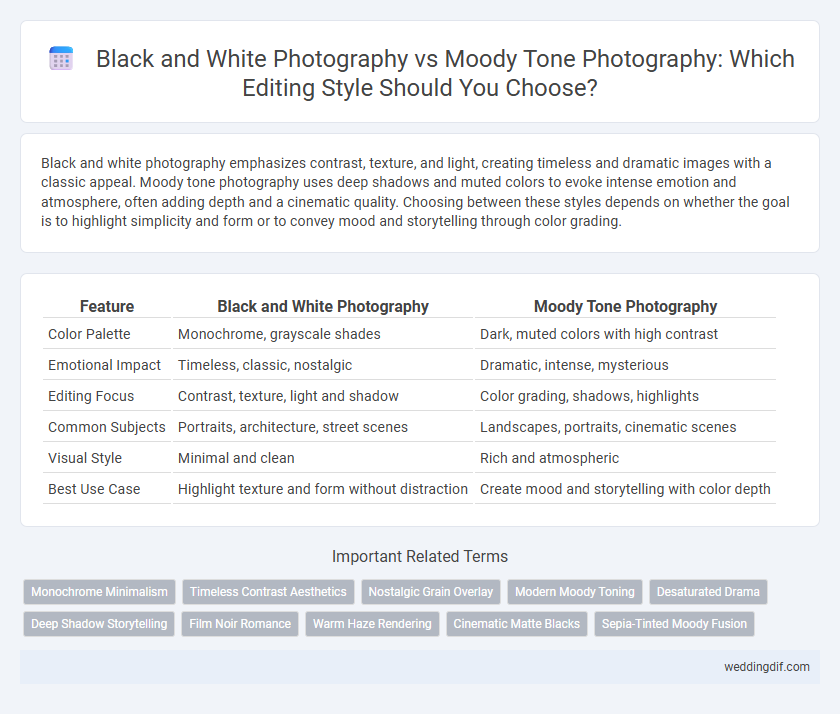Black and white photography emphasizes contrast, texture, and light, creating timeless and dramatic images with a classic appeal. Moody tone photography uses deep shadows and muted colors to evoke intense emotion and atmosphere, often adding depth and a cinematic quality. Choosing between these styles depends on whether the goal is to highlight simplicity and form or to convey mood and storytelling through color grading.
Table of Comparison
| Feature | Black and White Photography | Moody Tone Photography |
|---|---|---|
| Color Palette | Monochrome, grayscale shades | Dark, muted colors with high contrast |
| Emotional Impact | Timeless, classic, nostalgic | Dramatic, intense, mysterious |
| Editing Focus | Contrast, texture, light and shadow | Color grading, shadows, highlights |
| Common Subjects | Portraits, architecture, street scenes | Landscapes, portraits, cinematic scenes |
| Visual Style | Minimal and clean | Rich and atmospheric |
| Best Use Case | Highlight texture and form without distraction | Create mood and storytelling with color depth |
Introduction: Choosing Your Editing Style
Black and white photography emphasizes contrast, texture, and composition, creating timeless, classic images by stripping away color distractions. Moody tone photography enhances shadows, deep blacks, and muted highlights to evoke emotion and drama within the scene. Selecting between these editing styles depends on the desired storytelling approach and visual impact in the final image.
Defining Black and White Wedding Photography
Black and white wedding photography emphasizes timeless elegance by removing color distractions, highlighting contrast, texture, and emotion to create classic, expressive images. Moody tone photography for weddings enhances atmosphere through darker shadows and muted colors, adding depth and a cinematic feel. Choosing between black and white or moody tones depends on desired emotional impact and storytelling style, with black and white excelling in simplicity and timelessness.
Understanding Moody Tone Wedding Photography
Moody tone wedding photography emphasizes deep shadows and rich contrast to evoke emotional depth and intimacy, contrasting with the timeless simplicity of black and white photography that focuses on light, form, and texture. This editing style uses muted colors and darker hues to create a dramatic atmosphere, enhancing the storytelling aspect of wedding images. Understanding the moodiness in tone allows photographers to convey a personalized narrative, making each shot feel cinematic and emotionally resonant.
Emotional Impact: Black and White vs Moody Tone
Black and white photography emphasizes contrast and texture, stripping away color to evoke timeless emotions and highlight raw expressions. Moody tone photography uses dark shadows and desaturated hues to create a dramatic, atmospheric feeling that intensifies mood and storytelling. Both styles amplify emotional impact differently, with black and white focusing on purity and simplicity, while moody tones emphasize depth and complexity.
Storytelling with Black and White Imagery
Black and white photography emphasizes contrast and texture to create timeless, emotive storytelling by stripping images down to their essential visual elements. Moody tone photography enhances narrative depth through dark shadows and rich gradients, fostering atmosphere and emotional intensity. Choosing black and white imagery often leads to a more universal and classic storytelling experience, focusing viewers on composition and emotion without the distraction of color.
Evoking Atmosphere with Moody Tones
Black and white photography emphasizes contrast and texture, creating timeless and dramatic visuals that highlight form and emotion. Moody tone photography enhances atmosphere by using deep shadows, muted colors, and subtle lighting, evoking a sense of mystery and intensity. Photographers seeking to evoke rich atmospheres often prefer moody tones for their ability to convey complex moods and emotional depth beyond monochrome simplicity.
Suitability for Different Wedding Themes
Black and white photography excels in classic and timeless wedding themes, emphasizing emotion and contrast without the distraction of color. Moody tone photography suits dramatic and intimate wedding styles, enhancing depth and atmosphere with rich shadows and subdued highlights. Choosing between the two depends on the couple's desired mood, with black and white offering elegance and moody tones delivering cinematic storytelling.
Editing Workflow: Black and White vs Moody Tone Techniques
Black and white photography editing emphasizes contrast, texture, and tonal range to create striking monochromatic images, often utilizing dodge and burn techniques for depth. Moody tone photography focuses on manipulating color grading, shadows, and highlights to evoke atmosphere and emotion, frequently applying desaturation and split toning for dramatic effect. Both workflows require tailored adjustments in exposure and curves, but black and white editing prioritizes luminance, while moody tone editing emphasizes color dynamics and mood enhancement.
Client Preferences and Trends in Wedding Photography
Black and white photography remains a timeless choice in wedding photography, favored by clients seeking classic, elegant images that emphasize emotion and contrast without distraction. Moody tone photography is increasingly popular for couples wanting dramatic, atmospheric edits with rich shadows and muted highlights, reflecting contemporary trends in wedding storytelling. Client preferences often hinge on the couple's vision and venue, with black and white suited for traditional settings and moody tones appealing to rustic or vintage-inspired weddings.
Making the Right Choice for Your Portfolio
Choosing between black and white photography and moody tone photography depends on your portfolio's storytelling goals and emotional impact. Black and white photography emphasizes contrast, texture, and timelessness, making it ideal for classic, artistic presentations. Moody tone photography enhances atmosphere and depth with rich shadows and muted colors, which suits dramatic, narrative-driven projects.
Black and White Photography vs Moody Tone Photography for editing preference. Infographic

 weddingdif.com
weddingdif.com